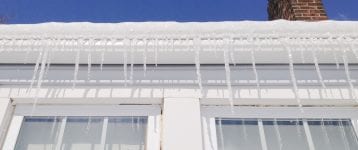When the weather turns cold, not only is it necessary to heat your home and keep your family warm, but other factors need to be considered – such as preventing the pipes from freezing. With the right drainage services in New Jersey, you can design a system that enables the proper flow of drinking water and wastewater.
But there are still times when the freezing temperatures can cause drainage systems to be blocked. One of the problems is that when the water freezes, it has unique properties that make it expand. As a result, ice within the drainage systems can put unnecessary pressure on the pipes, eventually causing them to break.
So, if your pipes are freezing, then you need to take a proactive approach to thaw them as quickly as possible – and prevent frozen pipes in the future. If you have serious issues or recurring problems with frozen pipes, then it might be time to call in an expert team to help with drainage services in New Jersey.
A Proactive Approach to Ensuring Your Drainage Systems Don’t Freeze
The key to avoiding water issues is by proactively installing drainage systems that are designed for your unique site conditions. Proper installation matters, because it prevents the drainage system from freezing when the temperatures drop. So, instead of waiting to see if the pipes will freeze, a better solution is to work with an experienced contractor who can help with the ideal installation, depth, and pitch that will reduce the likelihood of these problems in the future.
There are different drainage systems you might consider, including storm drainage, subsurface drainage, and surface drainage. The goal is to collect and transport water effectively so it doesn’t freeze and block or damage the drainage system during the coldest months of the year.
First, an experienced contractor will evaluate the site conditions, then they can offer recommendations on the type of drainage and materials that should be used. This process involves a strategy for drainage channels and pipes, with a clear method for where the water will go. Not only does proper depth impact the flow of the water, but the ideal pitch ensures that the runoff is always moving in the direction of the drainage system. Keeping the drainage running is a key factor to reduce the risk of freezing.
The site must first be excavated properly to achieve the desired depth and pitch. Then, pipe placement can be completed. With the right installation, you are creating a permanent, long-term solution that minimizes the risk of water issues in the future.
Additional Ways to Prevent Your Drainage System from Freezing
While there are strategies that you can use to thaw frozen drainage pipes, the best solution is to prevent frozen pipes so there is no need to call for drainage services in New Jersey. Here are a few tips to keep a pipe from freezing:
- Turn up the heat so the ambient temperature in the house is a little warmer
- Let the faucets drip so the water is always running
- Seal holes and cracks around the pipes
- Place electric heating tape on the areas that are prone to freezing.
A little bit of prevention goes a long way to minimize damage and expensive repairs in the future.
Three Methods for Thawing Frozen Drainage Systems
Often, it’s not realistic to wait for the pipe to thaw naturally, because the ongoing winter weather will keep freezing temperatures for weeks or months at a time. So, you might need to intervene with DIY strategies or call for drainage services to thaw the system and ensure that the pipes are flowing correctly.
The first step is to locate the frozen pipe(s). You need to know exactly where the drainage system is frozen so you know where to focus your efforts to thaw the blockage. Typically, the frozen sections are located on an exterior wall because that’s where the pipes are exposed to the freezing temperatures outside. So, start looking there.
Also, don’t underestimate the benefits of bringing in an experienced team to help with drainage services in New Jersey. Not only can a plumbing pro offer support in identifying the location where the pipes are frozen, but they can also assist with effective methods for thawing the frozen drainage system and preventing these issues from happening again in the future.
1. Salt
Did you know that salt lowers the melting point of ice? As a result, you can return ice to liquid even when the conditions are cold enough to otherwise keep ice solid. If you want to thaw the frozen pipe more quickly, then a salt application can be effective.
If you have cold weather and the plumbing system isn’t draining right, try putting salt down the drain that is being affected. A tablespoon of regular salt is often sufficient. Simply pour it down the drain and leave it alone so the salt can start acting on the ice.
2. Electric Heater
Another way to thaw a frozen pipe is to increase the ambient temperature around the pipe. For example, you can thaw the pipes by placing a space heater or heat lamp nearby to warm up the room.
If you know the specific area of the pipe that needs to be thawed, then heat guns can also offer fast and effective results since you can direct the heat to one part of the pipe. Even a hair dryer on the lowest setting can be sufficient – so there is no need to buy special tools.
Another option is to place a heating pad on the pipe. An electric heating pad offers consistent warmth to help the ice melt. Or, you can place a hot water bottle over the pipe for the same effect. You can easily create a homemade water bottle using hot water in a sealed gallon-sized Ziplock bag.
If you are using any type of heat lamp or space heater, remember that these tools can be a fire hazard, especially if there are any open flames. So, it’s best to stay nearby. Never turn the space heater up and walk away.
3. Garden Hose
It’s essential to drain the garden hose before winter begins. But if you forgot to drain the hose and you find a frozen hose after the temperature drops, it is relatively simple to thaw the hose. For example, use a hair dryer to apply heat to the outside of the hose so that the ice inside will start to melt. It’s best to use the lowest setting on the hair dryer because the hottest setting can cause the rubber to melt.
Other pipe thawing methods listed above can also be used to thaw a garden hose, including a heating pad on the frozen section or placing the hose in front of a space heater.
Speak With a Professional in New Jersey Drainage Services
When should you call a professional plumber to help with drainage services in New Jersey? If you need assistance with your plumbing system or thawing frozen pipes, then it is always a good idea to bring in the experts.
Mikula Contracting is here to help with everything that you need. Contact us at your convenience to learn more about available services, including residential drainage, commercial drainage, and more.



